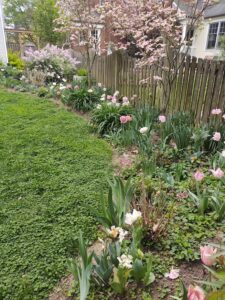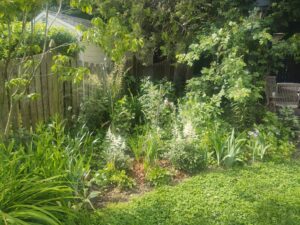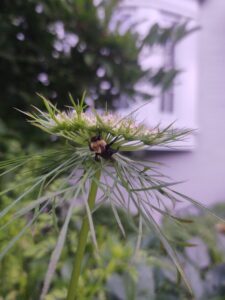Wildlife-Friendly Spring Cleanup
April 22, 2023 – Lynda DeWitt
This spring, Sust crews began with spring cleanups — dozens of them. And we all know the drill — removing leaves and debris from garden beds, collecting fallen branches and twigs from grassy areas, cutting back liriope and other ornamental grasses, and clearing pathways, patios, and other hard surfaces. Many customers also want us to weed and add shredded hardwood mulch to garden beds.

A mixed bed of native and non-native perennials brighten up a border in Anne’s D.C. backyard.
But just like you wouldn’t throw out winter clothes or holiday decorations when spring cleaning your house, it’s important to leave useful “stuff” behind. Leaves, old seed heads, spent perennials all provide shelter and food for insects over the winter. Come spring, caterpillars of butterflies and moths along with young of other beneficial insects are nestled in that useful debris, so best to leave it in place or gently move behind a shed or in a back corner, so insects inside can safely leave.
One of our customers, Anne, who lives on a tenth of an acre in Washington D.C. is ahead of the curve on wildlife-friendly cleanups. By leaving leaves, twigs, and perennial stalks in place over the winter and doing light spring cleanups the last several years, Anne has created an urban oasis.

Another mixed perennial bed, shown last May, provides food and shelter for insects, birds, and other wildlife.
“I’m amazed how quickly we found all kinds of creatures in our garden,” says Anne, “including nesting birds, many different varieties of bees and moths, monarch butterflies, lots of ladybugs, and hummingbirds. We always had lightning bugs at our house, but I think their numbers have increased since I started this approach. I have even found a frog hiding in the foliage on two occasions, and we don’t have a water source on our property.
“I get such joy from seeing all the life that is attracted to the garden and have found no problem peacefully co-existing with all these creatures,” Anne continues. “I love seeing them, and my tween kids do, too.”

A bee does what bees do on a Queen Anne’s lace bloom in Anne’s experimental wildflower meadow.
On a weedy patch where grass is struggling to grow, Anne decided to try growing a petite wildflower meadow.
“I noticed some really pretty wildflower seedlings growing in this area, including Queen Anne’s Lace,” says Anne. “This year I decided to sow some wildflower seed mix and just stop mowing this one sliver of lawn to see what happens. It’s an experiment, and we will just have to wait to see if it works out the way I hope.”
Anne’s garden is not all native. “I grow peonies, dahlias, and lots of daffodils and tulips,” she says. “I take the approach that I can have all these beautiful, highly cultivated plants that I want and still have plenty of space for wildlife-friendly plants. I care a lot about whether the garden looks attractive or not, so I work hard to use all these plants intermingled in a sophisticated and artful way. It definitely does not need to be an all-or-nothing approach. Every little bit helps.”
We here at Sust thank you, Anne, for your business and for your beautiful “little bit.”


